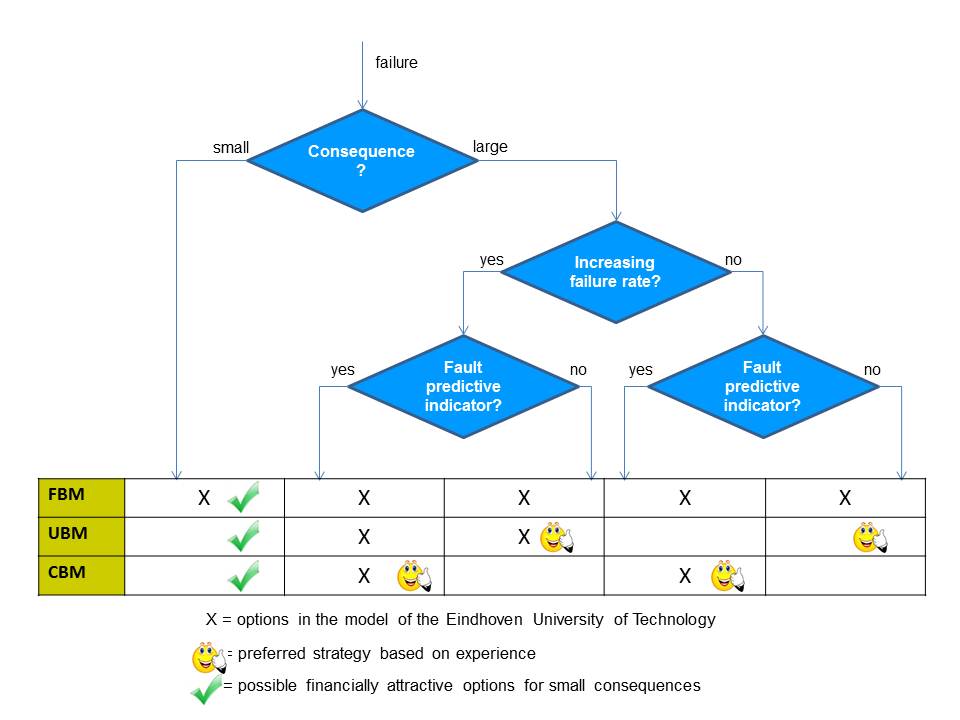When which maintenance strategy?
16 November 2012 • John de Croon
risk management, policy development, planning
In a previous column, we described that often only 10% of assets is 'touched' per year. We received a response to that column (nice!) that this was recognised including the statement that the company in question is considering to conduct more condition-based maintenance. This would result in a higher availability, but it was not yet clear whether it was feasible. We hear this frequently: what maintenance strategy should be applied? I will elaborate on this in this column.
The asset management process 'policy development' can result in a decision that more preventive maintenance should be carried out, resulting in for example an increased availability of assets. Then the question is what kind of preventive maintenance is most attractive. Sometimes it is quite difficult to determine this. There are different types of maintenance. In this column, three maintenance strategies are taken into account: Failure Based Maintenance (FBM), Use Based Maintenance (UBM) and Condition Based Maintenance (CBM). In FBM a repair is made after a fault has occurred. UBM is a kind of preventative maintenance, in which after a fixed time or usage period (eg for a car 1x/year or after 15.000 kilometres) service is executed. CBM is also preventative maintenance, which is executed when the condition does not meet predetermined criteria. In the Netherlands often a model of the Eindhoven University of Technology is applied[1]. The model indicates what kind of maintenance canbe applied. Some comments can be made on the model. Thus, the first choice (big or small consequence) is rather arbitrary, because with a small impact preventive maintenance can still be attractive. Also it is not stated which maintenance strategy can best be applied. If we incorporate these observations in the model, then the figure below appears.

If the returns of a strategy are greater than the costs of it, it is attractive to choose for that strategy. According to our experience for aging assets which have predictive indicators (optimisable) use based inspection is preferred. For non-aging assets with a predictive indicator CBM is the most attractive by means of continuous monitoring. After all you cannot optimise the inspection interval. This classification is correct as long as the corrective maintenance is more expensive than preventative maintenance and preventative maintenance is more expensive than the inspection. Corrective maintenance is almost always more expensive than preventative maintenance due to the unplanned nature of corrective maintenance.
Suppose you are considering CBM. In the figure it can be seen that for the introduction of CBM a predictive indicator needs to be available. Often there is a predictive parameter, but is the probability of detection in many cases is not 100%.
The before mentioned returns contain the risk reduction per year (lower costs of non-availability of the function, but it can for example also be the monetary value of the reduced security incidents), where the probability of detection of the risk is considered. For the cost should be taken into account the investment needed to implement CBM (eg drafting the maintenance concepts, purchase equipment, train staff) and annual costs (eg licensing of a measurement method, maintenance of equipment and also the periodic evaluation costs of the maintenance concepts). And of course we calculate the net present values for the revenues and costs[2]. In asset management, we want to compare more than one option to ensure a maximum value creation. Thus you need to conduct the exercise for the various strategies. The table below summarises it for a fictitious example in which a predictive indicator is available, and where in the case of FBM the failure costs are 10k euros per year.

In this case the lowest cost per year are achieved with CBM[3]. Note that the ´conservation fee´ for the maintenance concepts themselves are not yet included.
One thing I have not touched and that is perhaps the most important. In practice we often see that on a central organisational level maintenance concepts are established, in which experience from the field is not always incorporated. Or at central level the assumption is made that when the new maintenance concepts are set up, these concepts will be applied automatically. The message is: maintenance is done by humans, so involve relevant people. That often results in more savings, then defining a new maintenance strategy.
[3] When the costs and benefits are in a different period then the yield must be determined. This can be calculated by dividing the advantages (reduction of failure costs in this case) by the preventive and (if applicable) repair costs after inspection.
John de Croon is partner at AssetResolutions BV, a company he co-founded with Ype Wijnia. In turn, they give their vision on an aspect of asset management in a weekly column. The columns are published on the website of AssetResolutions, http://www.assetresolutions.nl/en/column
<< back to overview
|


